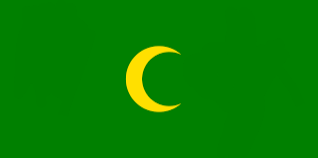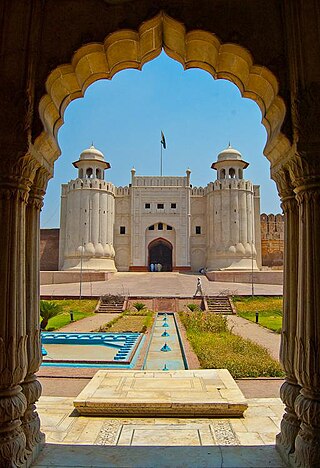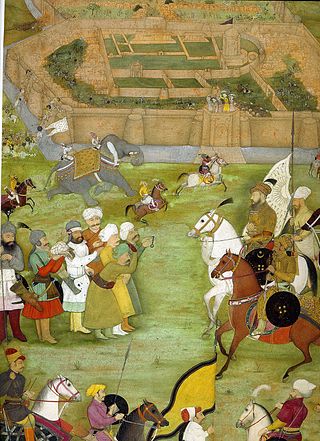Related Research Articles

Babur, born Zahīr ud-Dīn Muhammad, was the founder of the Mughal Empire in the Indian subcontinent. He was a descendant of Timur and Genghis Khan through his father and mother respectively. He was also given the posthumous name of Firdaws Makani.

Mirza Nasir-ud-Din Muhammad, better known by his regnal name Humāyūn, was the second Mughal emperor, who ruled over territory in what is now Eastern Afghanistan, Bangladesh, Northern India, and Pakistan from 1530 to 1540 and again from 1555 to 1556. At the time of his death in 1556, the Mughal Empire spanned almost one million square kilometres.

Jahanara Begum was a Mughal princess and later the Padshah Begum of the Mughal Empire from 1631 to 1658 and again from 1668 until her death. She was the second and the eldest surviving child of Emperor Shah Jahan and Mumtaz Mahal.

Mughal emperors were the supreme heads of state of the Mughal Empire on the Indian subcontinent, mainly corresponding to the modern countries of India, Pakistan, Afghanistan and Bangladesh. The Mughal rulers styled themselves as Badshah or Shahanshah, a title usually translated from Persian as "emperor". They began to rule parts of India from 1526, and by 1707 ruled most of the sub-continent. After that they declined rapidly, but nominally ruled territories until the Indian Rebellion of 1857.

The Agra Fort is a historical fort in the city of Agra, and also known as Agra's Red Fort. Mughal emperor Humayun was crowned at this fort. It was later renovated by the Mughal emperor Akbar from 1565 and the present-day structure was completed in 1573. It served as the main residence of the rulers of the Mughal dynasty until 1638, when the capital was shifted from Agra to Delhi. It was also known as the "Lal-Qila" or "Qila-i-Akbari". Before capture by the British, the last Indian rulers to have occupied it were the Marathas. In 1983, the Agra fort was inscribed as a UNESCO World Heritage Site because of its importance during the Mughal Dynasty. It is about 2.5 kilometers (1.6 mi) northwest of its more famous sister monument, the Taj Mahal. The fort can be more accurately described as a walled city. It was later renovated by Shah Jahan.

Mughal architecture is the type of Indo-Islamic architecture developed by the Mughals in the 16th, 17th and 18th centuries throughout the ever-changing extent of their empire in the Indian subcontinent. It developed from the architectural styles of earlier Muslim dynasties in India and from Iranian and Central Asian architectural traditions, particularly Timurid architecture. It also further incorporated and syncretized influences from wider Indian architecture, especially during the reign of Akbar. Mughal buildings have a uniform pattern of structure and character, including large bulbous domes, slender minarets at the corners, massive halls, large vaulted gateways, and delicate ornamentation; examples of the style can be found in modern-day Afghanistan, Bangladesh, India and Pakistan.

The Bāburnāma is the memoirs of Ẓahīr-ud-Dīn Muhammad Bābur (1483–1530), founder of the Mughal Empire and a great-great-great-grandson of Timur. It is written in the Chagatai language, known to Babur as Türki ("Turkic"), the spoken language of the Timurids. During the reign of emperor Akbar, the work was translated into Persian, the usual literary language of the Mughal court, by a Mughal courtier, Abdul Rahim Khan-i-Khanan, in AH 998.

The Mughal dynasty comprised the members of the imperial House of Babur (Persian: خاندانِ آلِ بابُر; Khāndān-e-Āl-e-Bābur), also known as the Gurkanis, who ruled the Mughal Empire from c. 1526 to 1857.

Kamran Mirza was the second son of Babur, the founder of the Mughal Empire and the first Mughal Emperor. Kamran Mirza was born in Kabul to Babur's wife Gulrukh Begum. He was half-brother to Babur's eldest son Humayun, who would go on and inherit the Mughal throne, but he was full-brother to Babur's third son, Askari. A divan written in Persian and Chagatai is attributed to him.

Delhi has been an important political centre of India as the capital of several empires. The recorded history of Delhi begins with the 8th century Tomar Rajputs kingdom. It is considered to be a city built, destroyed and rebuilt several times, as outsiders who successfully invaded the Indian subcontinent would ransack the existing capital city in Delhi, and those who came to conquer and stay would be so impressed by the city's strategic location as to make it their capital and rebuild it in their own way.

Ghiyath al-Din Muhammad, commonly known as Khvandamir was a Persian historian who was active in the Timurid, Safavid and Mughal empires. He is principally known for his Persian universal history, the Habib al-siyar, which was regarded by both the Safavids and Mughals as their first official court account.

The Mughal Empire was an early modern empire based in South Asia between the 16th and 19th centuries. For some two hundred years, the empire stretched from the outer fringes of the Indus River Basin in the west, northern Afghanistan in the northwest, and Kashmir in the north, to the highlands of present-day Assam and Bangladesh in the east, and the uplands of the Deccan Plateau in South India.

From 1524 to 1752, Lahore was part of the Mughal Empire. Lahore touched the zenith of its glory during the Mughal rule from 1524 to 1752. The Mughals, who were famous as builders, gave Lahore some of its finest architectural monuments, many of which are extant today.

The Army of the Mughal Empire was the force by which the Mughal emperors established their empire in the 15th century and expanded it to its greatest extent at the beginning of the 18th century. Although its origins, like the Mughals themselves, were in the cavalry-based armies of central Asia, its essential form and structure was established by the empire's third emperor, Akbar.
Ruqaiya Sultan Begum was the first and chief wife of the third Mughal emperor, Akbar.
Bega Begum was Empress consort of the Mughal Empire from 26 December 1530 to 17 May 1540 and 22 February 1555 to 27 January 1556 as the first wife and chief consort of the second Mughal emperor Humayun. She was known as Zan-i-Kalan being the first wife of Humayun and was also known as Haji Begum after she performed the Hajj pilgrimage.
During the Mughal Dynasty, urdubegis were the class of women assigned to protect the emperor and inhabitants of the zenana.

The Subah of Lahore was a province of the Mughal Empire encompassing the central Punjab region, now divided between Pakistan and India. It was created as one of the original 12 Subahs of the Mughal Empire under the administrative reforms carried by emperor Akbar in 1580. The province ceased to exist after the death of its last viceroy, Adina Beg in 1758, with large parts being incorporated into Durrani Empire.

The foreign relations of the Mughal Empire were characterized by competition with the Persian Empire to the west, the Marathas and others to the south, and the British to the east. Steps were taken by successive Mughal rulers to secure the western frontiers of India. The Khyber Pass along the Kabul- Qandhar route was the natural defence for India, and their foreign policy revolved around securing these outposts, as also balancing the rise of powerful empires in the region. During the break up of the Timurid Empire in the 15th century, the Ottomans in Turkey, the Safavids in Persia and the Uzbegs in central Asia emerged as the new contenders of power. While the Safavids were Shia by faith, Ottomans along with Uzbegs were Sunni. The Mughals were also Sunni and Uzbegs were their natural enemies, who caused Babur and other Timurid princes to leave Khurasan and Samarqand. The powerful Uzbegs who held sway over central India sought an alliance of Sunni powers to defeat the Shia ruled Persia, but Mughals were too broadminded to be driven away by the sectarian conflicts. The Mughal rulers, especially Akbar, were keen to develop strong ties with Persia in order to balance the warring Uzbegs. Thus, the foreign policy of Mughals was centred around strengthening the ties with Persia, while maintaining the balance of power in the region by keeping a check on the evolution of a united Uzbeg empire.